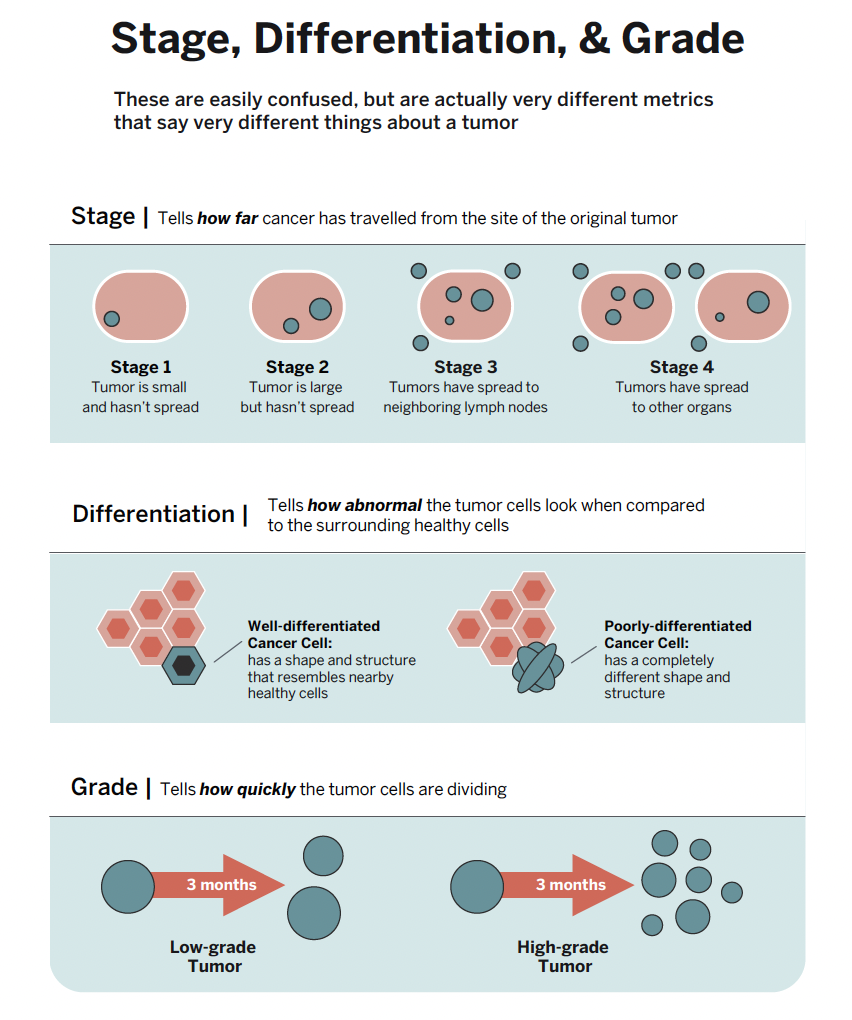Make a gift by December 2nd, 2025 to double your impact.
Home » For Patients » NET Grade & Stage
Your test results help your doctor to classify your tumor grade and cancer stage, which are important for establishing the plan for your treatment.
Tumor grade is based on how abnormal cancer cells and tissue look under a microscope and how quickly the cancer cells are likely to grow and spread. Laboratory analysis by a pathologist will determine tumor grade. Generally, a lower grade indicates a better prognosis. Usually, higher-grade cancers grow more quickly and require more aggressive treatment.

Well-differentiated: The tumor’s cells and the organization of tissue in the tumor resemble nearby healthy cells and the organization of normal tissue. Well-differentiated tumors tend to grow and spread slowly.
Poorly differentiated: These tumors have abnormal-looking cells and may lack normal tissue structures. Poorly differentiated tumors tend to grow quickly.
You should speak to your doctor for more information about your tumor grade and how it affects your treatment options and prognosis.
Ki-67 is a protein that indicates cell division, or proliferation. Pathologists use tumor tissue samples to test for Ki-67. This test can show the number of cells that are dividing and the number of cells that are dormant. The level of Ki-67 in cells increases as cells prepare to divide. If there is a high percentage of cells in a particular area of tumor tissue with a high Ki-67 level, this means the cells are quickly dividing.
The results of a Ki-67 test help to establish a grade for a tumor, which indicates how fast cancer may be growing. Ki-67 is expressed on a scale of zero to 100 percent.
The World Health Organization classifies NETs, as well as neuroendocrine carcinomas or NECs, based on how much cancer is present and how aggressive the cancer is. Among the determining factors in the grade of NETs is the Ki-67 index and whether the cancer is well-differentiated or poorly differentiated.
Low-grade NETs, grade 1 or 2, are defined as well-differentiated tumors with a Ki-67 index of less than 20%. These tumors are not as aggressive. High-grade tumors with a Ki-67 index of more than 20% are classified as grade 3.
Grade 3 tumors can be well-differentiated or poorly differentiated. Poorly differentiated Grade 3 tumors are referred to as NECs. These tumors grow faster, are more aggressive and are treated differently than lower-grade NETs.
If you have a high-grade NET or NEC, it is important to see a NET specialist with experience treating these more aggressive tumors. For more information on high-grade NETs, go to NETRF’s NETWise podcast on the topic. The HealingNET Foundation also has a publication with more information about high-grade neuroendocrine cancers.
Cancer stage refers to the extent of your cancer, depending on how large the tumor is and how far it has spread (metastasized). Knowing the stage of your cancer helps your doctor:
Doctors often use Stage I-IV to describe stages of cancer. If cancer comes back or spreads to other parts of the body, your doctor may “restage” your cancer. If treatment is successful, you may also hear the phrase “no evidence of disease” or “NED,” which means that current testing methods cannot detect any signs of cancer in the body.
Watch our 2022 KNOW YOUR NETs Patient Education Conference here.
Learn about NET patients and their journeys here.
Learn about NETRF funded research here.